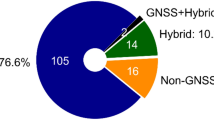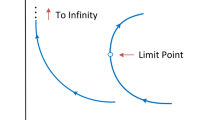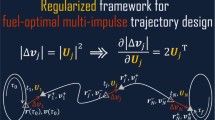Abstract
The NASA DART and ESA Hera missions to binary asteroid 65803 Didymos have generated a lot of interest in the study of spacecraft dynamics in the vicinity of binary asteroids. The combination of the effect of the irregular shape and the rotation of the primary bodies makes them not only non-linear, but also non-autonomous systems. This study uses a technique to design reference trajectories in the context of a mission to a binary asteroid system using a fourth-order gravitational potential model for the two primary bodies. The rotation of the primary bodies, their elliptical mutual motion and the solar radiation pressure are also considered in the model, which makes this study unique. It then compares the control effort required when these reference trajectories are used with that required when reference trajectories are built with simpler models. The goal is to examine how the choice of the model used to compute reference trajectories influences the control effort required to keep the spacecraft close to them.























Similar content being viewed by others
References
Margot, J. -L., Nolan, M.C., Benner, L.A.M., Ostro, S.J., Jurgens, R.F., Giorgini, J.D., Slade, M.A., Campbell, D.B.: Binary asteroids in the near-earth object population. Science 296, 1445–1448 (2002). https://doi.org/10.1126/science.1072094
Cheng, A.F., Rivkin, A.S., Michel, P., Atchison, J., Barnouin, O., Benner, L., Chabot, N.L., Ernst, C., Fahnestock, E.G., Kueppers, M., Pravec, P., Rainey, E., Richardson, D.C., Stickle, A.M., Thomas, C.: AIDA DART ssteroid deflection test: planetary defence and science objective. Planet. Space Sci. 157, 104–115 (2018). https://doi.org/10.1016/j.pss.2018.02.015
Michel, P., Kueppers, M., Sierks, H., Carnelli, I., Cheng, A.F., Mellab, K., Granvik, M., Kestilä, A., Kohout, T., Muinonen, K., Näsilä, A., Penttila, A., Tikka, T., Tortora, P., Ciarletti, V., Hérique, A., Murdoch, N., Asphaug, E., Rivkin, A., Barnouin, O., Bagatin, A.C., Pravec, P., Richardson, D.C., Schwartz, S.R., Tsiganis, K., Ulamec, S., Karatekin, O.: European component of the AIDA mission to a binary asteroid: characterization and interpretation of the impact of the DART mission. Adv. Space Res. 62, 2261–2272 (2017). https://doi.org/10.1016/j.asr.2017.12.020
Manghi, R.L., Modenini, D., Zannoni, M., Tortora, P.: Preliminary orbital analysis for a CubeSat mission to the Didymos binary asteroid system. Adv. Space Res. 62, 2290–2305 (2018). https://doi.org/10.1016/j.asr.2017.12.014
Farqhar, R.W.: The Control and Use of Libration-Point Satellites, Ph.D. Thesis, Stanford University (1968)
Breakwell, J.V., Brown, J.V.: The ‘Halo’ family of 3-dimensional periodic orbits in the earth-moon restricted 3-body problem. Celest. Mech. 20, 389–404 (1979). https://doi.org/10.1007/BF01230405
Howell, K.C.: Three-dimensional, periodic, ‘halo’ orbits. Celestial Mechanics 32, 53–71 (1984). https://doi.org/10.1007/BF01358403
Heiligers, J., Macdonald, M., Parker, J.S.: Extension of earth-moon libration point orbits with solar sail propulsion. Astrophysics and Space Science 361, 241 (2016). https://doi.org/10.1007/s10509-016-2783-3
Bellerose, J., Scheeres, D.J.: General dynamics in the restricted full three body problem. Acta Astronaut. 62, 563–576 (2008). https://doi.org/10.1016/j.actaastro.2008.01.018
Woo, P., Misra, A.K., Keshmiri, M: On the planar motion in the full two-body problem with inertial symmetry. Celest. Mech. Dyn. Astron. 117, 263–277 (2013). https://doi.org/10.1007/s10569-013-9512-9
Woo, P., Misra, A.K.: Bounded trajectories of a spacecraft near an equilibrium point of a binary asteroid system. Acta Astronaut. 110, 313–323 (2015). https://doi.org/10.1016/j.actaastro.2014.11.001
Dobrovolskis, A.R.: Inertia of any polyhedron. Icarus 124, 698–704 (1996). https://doi.org/10.1006/icar.1996.0243
Jean, I., Misra, A.K., Ng, A.: Solar radiation pressure-compatible trajectories in the vicinity of a binary asteroid. Journal of Guidance, Control, and Dynamics 42, 1319–1329 (2019). https://doi.org/10.2514/1.G004007
Jean, I., Ng, A., Misra, A.K.: Impact of solar radiation pressure modelling on orbital dynamics in the vicinity of binary asteroids. Acta Astronaut. 165, 167–183 (2019). https://doi.org/10.1016/j.actaastro.2019.09.003
Davis, A.B., Scheeres, D.J.: Sensitivity of trajectories to mass parameters in the restricted full three body problem. AAS Astrodynamics Specialists Conference, Portland, Maine (2019)
Marchand, B.G., Howell, K.C., Wilson, R.S.: Improved corrections process for constrained trajectory design in the n-body problem. J. Spacecr. Rocket. 44, 884–197 (2007). https://doi.org/10.2514/1.27205
Li, X., Qiao, D., Li, P.: Bounded trajectory design and self-adaptive maintenance control near non-synchronized binary systems comprised of small irregular bodies. Acta Astronaut. 152, 768–781 (2018). https://doi.org/10.1016/j.actaastro.2018.09.028
Ferrari, F., Lavagna, M.: Periodic motion around libration points in the elliptic restricted three-body problem. Nonlinear Dynamics 93, 453–462 (2018). https://doi.org/10.1007/s11071-018-4203-4
Capannolo, A., Ferrari, F., Lavagna, M.: Families of bounded orbits near binary asteroid 65803 didymos. Journal of Guidance, Control and Dynamics 42, 189–198 (2019). https://doi.org/10.2514/1.G003437
Jean, I., Misra, A.K., Ng, A.: Orbital ans attitude coupled dynamics of a spacecraft around an asteroid. Adv. Astronaut. Sci. 161, 267–283 (2017)
Kikuchi, S., Howell, K.C., Tsuda, Y., Kawaguchi, J.: Orbit-attitude coupled motion around small bodies: sun-synchronous orbits with sun-tracking attitude motion. Acta Astronaut. 140, 34–48 (2017). https://doi.org/10.1016/j.actaastro.2017.07.043
McInnes, C.R.: Solar Sailing: Technology, Dynamics and Mission Applications. Springer, Berlin (2004). ISBN 978-1-85233-102-3
Farrés, A., Folta, D., Webster, C.: Using spherical harmonics to model solar radiation pressure accelerations. Adv. Astronaut. Sci. 162, 3365–3383 (2018)
Doedel, E.J., Paffenroth, R.C., Keller, H.B., Dichmann, D.J., Galàn-Vioque, J., Vanderbauwhede, A.: Computation of periodic solutions of conservative systems with application to the 3-body problem. International Journal of Bifurcation and Chaos 13, 1353–1381 (2003). https://doi.org/10.1142/S0218127403007291
Doedel, E.J., Romanov, V.A., Paffenroth, R.C., Keller, H.B., Dichmann, D.J., Galàn-Vioque, J., Vanderbauwhede, A: Elemental periodic orbits associated with the libration points in the circular restricted 3-body problem. International Journal of Bifurcation and Chaos 17, 2625–2677 (2007). https://doi.org/10.1142/S0218127407018671
Naidu, S., Benner, L., Brozovic, M., Ostro, S.J., Nolan, M.C., Margot, J.L., Giorgini, J.D., Magri, C., Pravec, P., Scheirich, P., Scheeres, D.J., Hirabayashi, M.: Observations and characterization of binary near-earth asteroid 65803 didymos, the target of the AIDA mission, American Geophysical Union, Fall General Assembly abstract id.P52B-02. http://adsabs.harvard.edu/abs/2016AGUFM.P52B..02N (2016)
Acknowledgements
The authors acknowledge that the research described in this paper has been made possible with the help of the Natural Sciences and Engineering Research Council of Canada (NSERC), Grant Nos. CGSD3-489994-2016 and A-0967, the “Fonds de Recherche du Québec: Nature et Technologies” (FRQNT), Grant No. 198852, and McGill University (a McGill Engineering Doctoral Award to the first author).
Author information
Authors and Affiliations
Corresponding author
Ethics declarations
Conflict of Interests
On behalf of all authors, the corresponding author states that there is no conflict of interest.
Additional information
Publisher’s Note
Springer Nature remains neutral with regard to jurisdictional claims in published maps and institutional affiliations.
Appendix: Calculation of the inertia integrals based on a polyhedron shape model
Appendix: Calculation of the inertia integrals based on a polyhedron shape model
The expressions for the inertia integrals can be calculated by integration for simple geometrical shapes, such as a triaxial ellipsoid. They can also be calculated based on the polyhedron shape of the primary bodies for arbitrary shape. A method to calculate the second order inertia integrals is developed by [12] and summarized here. The fourth order inertia integrals can also be calculated using a similar method.
A polyhedron shape model is composed of tetrahedrons having their triangular faces composing the external shape of the body. Each face is described by the vector of coordinates of the vertices composing it, named here D, E and F as in Fig. 24. The edges G and H are defined as follow:
All of the coordinates of the model are defined with respect to the origin O which does not necessarily correspond to the center of mass of the arbitrarily shaped body.
The first things to define are the area of a facet, the volume of a tetrahedron and the center of mass of the body modeled using a polyhedron shape.
The area of a facet, ΔS is the norm of the cross product of the edges G and H divided by 2:
The total surface of the body is then the sum of all the ΔSs.
The volume of a tetrahedron is 1/3 its height multiplied by the surface of its facet:
Here again, the total volume of the body is the sum of the ΔV s.
Considering that the body has uniform density ρ, each tetrahedron can be considered having a mass of ΔM = ρΔV. The centroid of a tetrahedron is calculated by:
The center of mass R of the body as a whole is calculated as follow:
Second Order Inertia Integrals and Moments of Inertia
The calculation of the second moments of inertia is well described by [12] and will be summarized here. The second order moments of inertia can be represented in the inertia matrix of the body:
since Ijk = Ikj, there are only six values to calculate to get the full inertia matrix. Each term of the inertia matrix can be calculated are follow:
where:
where the triple integral in x, y, and z is done over the volume of the body with a uniform density ρ. The results are the second order inertia integrals of the body.
Dobrovolskis [12], simplified the volume integral using Gauss’ theorem which states that the integral of a value q = ∇⋅Q over a closed volume V is equal to the integral of Q over its boundary S:
In the present case, dS is a vector in the direction normal to the surface S with a magnitude equal to the element of area dS. Taking the vector Q parallel to the radius vector r going from the origin to an arbitrary point on the external facet assures that only the external surface contribute to the integral. The simplest choice of Q is then jkr/5. The products of inertia then become:
Considering that:
the integral to evaluate is then:
To simplify the integral, let us define dimensionless coordinates \(\left (g,h\right )\) in the plane of the facet D, E, F such that:
We then have:
The element of area dS then becomes Ndgdh. Inserting the last results into Eq. 35 gives:
With the limit of integration being either 0 < g < 1 − h, 0 < h < 1 or 0 < h < 1 − g, 0 < g < 1, it can be shown that:
Substituting in Eq. 38 and applying G = E −D and H = F −D, gives the final result:
As previously, Jjk is the sum of the ΔJjk.
At this point, the inertia matrix is populated, but the origin of the reference frame used to define the position of the vertices is not necessarily the center of mass of the body and the reference frame is not necessarily aligned with the principal axes. First, let us use the parallel axis theorem to calculate the equivalent moments and product of inertia for a reference frame having its origin at the center of mass of the body. By using the previously calculated center of mass of the body with coordinates X, Y and Z:
Because the inertia matrix is composed of real numbers and is symmetric, its eigenvalues are also real numbers and its eigenvectors are orthogonal. The direction cosine matrix (DCM) describing the orientation of the actual reference frame relative to reference frame aligned with the principal axes is then the matrix composed of the eigenvectors of the inertia matrix with the reference frame aligned with the center of mass of the body. Transposing it gives the DCM describing the reference frame having origin at the principal axes of the body relative to the original reference frame. Knowing that, it is then possible to calculate the coordinates of each vertices into the reference frame aligned with the principal axes of the body (body i fixed reference frame)and having its origin at the center of mass of the body. Applying Eq. 40 to the modified coordinates show that the products of inertia have now negligible values compared to the principal moments of inertia. These modified coordinates will be used to calculate the fourth order inertia integrals of the body.
Fourth Order Inertia Integrals
Using the modified coordinates for the calculation of the fourth order inertia integrals permits to only calculate the following six values, the other ones being null:Jxxxx, Jyyyy, Jzzzz, Jxxyy, Jyyzz, Jzzxx. The same method than the one described in [12] is used here. In the fourth order case, Q is (jk)2r/7. The integrals that need to be evaluated are then:
The required extra integrals for the calculation of the fourth order inertia integrals are then:
Substituting these results into Eq. 42 and after some algebra, the resulting calculation of the fourth order inertia integrals is:
The special case of Jjjjj is given by:
Rights and permissions
About this article
Cite this article
Jean, I., Misra, A.K. & Ng, A. Controlled Spacecraft Trajectories in the Context of a Mission to a Binary Asteroid System. J Astronaut Sci 68, 38–70 (2021). https://doi.org/10.1007/s40295-021-00248-1
Accepted:
Published:
Issue Date:
DOI: https://doi.org/10.1007/s40295-021-00248-1





